
“IF THEY WANT POSTCARDS, I MAKE POSTCARDS”
For the Silent. Silence. Silenced. show at Atlantic Works Gallery, Charlene Liska and I worked together to come up with an attractive and informative post card that would serve multiple purposes:
- A Hand-out to give friends and family.
- An immediate mailer/invitation. There’s no envelope to open.
- A good-looking ‘small flyer’ for us, fellow artist friends, and student volunteers to leave at coffee shops and to pin on announcement boards at museums, cultural organizations, and student centers, etc.
- A calling card for when we visit galleries this month.
- A possible bookmark and legacy stash.

Front of Charlene Liska’s postcard for Silent. Silence. Silenced.
Decisions to make before designing an Art Exhibit Post Card.
- What’s on the Front? Usually an image. Could be words.
- What Goes on the Back? Who-What-When-Where ( more later).
- Size. To qualify for First-Class Mail postcard rate the card has to be rectangular, at least 3-1/2 inches high x 5 inches long x 0.007 inch thick and be no more than 4-1/4 inches high x 6 inches long x 0.016 inches thick.
- Print Run. How many to print?
- Budget. How much money you have to spend on this aspect of promotion//marketing?
As far as print run: we decided to print 500 postcards and print two different front images. We shared identical print information on the back of the post card and varied the image on the front 250/250.
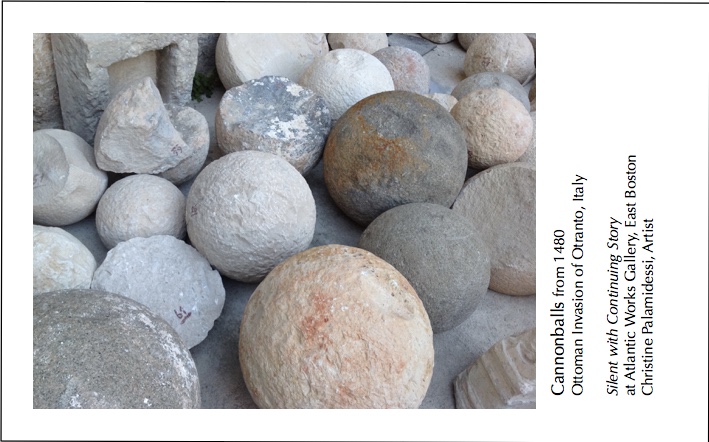
Front of Christine Palamidessi post card for Silent. Silence. Silenced.
Finally, here are the five main points to keep in mind when putting your post card all together:
- Plan ahead. Have the postcards ready 1-2 months before your show opens. This means not only do you need to design the card, but communicate with your printer to find out his/her lead time. So work backwards from your desired date of having the post-card in hand and then line up all the things you need to do to make it happen.
- Who. What. When and Where. Yes, you’ve heard this before and you’ll hear it again. Who (your name) What (name of show and definition of show–is it a pop-up, a month-longshow, a one nighter?) When (the run date of the show as well as the date of the Opening Night and any other special events during the run of the show) Where (name of the gallery, or venue, and the address. Include zip code and phone number of the gallery and the gallery/venue website. You may consider putting your own phone number on the card, as Charlene and I did, but realize your phone number may end up on someone’s solicitation list.
- Establish Credibility. Be sure to proofread everything. Use high resolution photos/jpg. A sloppy looking card communicates ‘a don’t care/don’t know/I make mistakes attitude’ — which you probably don’t want to do unless that’s the theme of your exhibit, which has its own set of decisions and contradictions not addressed here.
- Keep It Clean and Easy. Fewer words are better than a lot of words. People appreciate quick-to-eye grab information. (look at image below–left side of the back of postcard) to see how we varied caps and lower case, as well as grey and black inks.)
- Ask Friends and Art Community to Help Spread the Word & Distribute Your Post Cards (drop off, mail, post in their place of work) .


Conceptual Artist Walter Kopec and his ‘hangman’ word play drawing. At Atlantic Works Gallery, 2017.
Blue. Red. Black and White.
Not a hint of cowardly yellow bridges the Right with the Left; no grey softens the Yes and No, the Pro with the Con. There are no dips into non-objectivity. The work Walter Kopec is showing at Atlantic Work Gallery is elegant visual symbolism embedded with the tension of theoretical opposites set off against one another.
Kopec’s crisp, spare images–a pencil drawing, black tape on the wall, nail-pierced shoes, a grid of suspended red and blue ribbons–deliver complex messages; their controlled surfaces counter the irrational and compulsive inner workings of our American politics, culture and society.
The work relies on symbol and the openness of symbol interpretation. There are multiple references to the American flag. An impressive, mobile-like soft-sculpture, built from red and blue ribbons and fragments of picture frames, takes stage center. “Is the flag assembling, or disassembling?” Kopec asks. Nearby is a wall-sculpture, echoing the shape and material of the mobile sculpture but not its colors. It is a flag made of black and white stripes, which Kopec titles We Hold These Truths to Be Self-Evident “And the next part is, …that all men are created equal.” Kopec says, quoting the words of the U.S. Constitution. “And, it’s not just black-white racism that this work references,” he adds. “It’s also the black and white print medium– fact vs. fiction. Truth vs. fake news.”
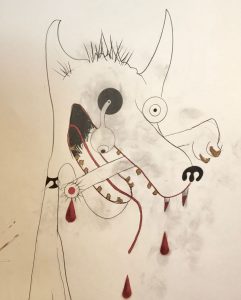
“The Last Dog Eats Alone” ( in a dog-eats-dog world) Pencil drawing with inks. Walter Kopec, 2017.
Kopec’s process is contemplative and never-ending. “I might go to my studio and read the dictionary. I might do word games, puzzles. I sit, think and write down ideas. I ask myself what’s happening in the world. What’s the drumbeat right now? ”
For 15 years Kopec’s been chronicling his ideas, words, stories. “I have boxes and boxes filled with sketches, notes, clippings, even fabric. What is this for? What can this mean? Can I use this? How? Explain it? How? For me, there’s really no start-stop in the conceptual process. My mind is always active. I even wake up at night and write notes.”
“My current conundrum,” Kopec says, “is that I grew up in the 60s and 70s. Experienced stuff that happened in the civil rights movement; during the Viet Nam War. The unfairness of it all.” Today he sees similar opposing forces fighting it out, except that now it is his generation that’s the cause of it. “The people I grew up with are responsible. What prompted this to start?” he wonders.
Two of the pieces in the show have Trump-related themes, though Kopec makes it clear he has not made
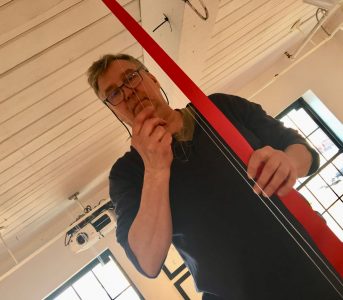
Walter Kopec in gallery installing the red stripes for …THINGS THAT REMAIN
Trump art or anti-Trump art, and that has no desire to put any of his brain power into Trump. “The art is about what is happening in society: special interests, politics for self-serving personnel gain. Trump just happened to bring it all to the forefront and pushed the ugliness in our faces.”
In the binary opposition of his show …AND THINGS THAT REMAIN, Kopec points a finger at the system we live in that considers everything either “right or wrong” , “winner or loser” ; “Democratic or Republican” ; “You’re either with us, or you’re with the terrorists.” Using cultural symbols and coded words he connects with emotions illustrating the continuing interrelated conflicts that he felt earlier in his career. “I certainly don’t have answers nor do I pretend to have answers to what’s happening,” Kopec affirms. “America is happiness. This is where people come to pursue happiness.” He points to a drawing on the wall of a stick figure running after a small American flag, which he titles Pursuit of Happiness. “ I’m not making judgement on any of this stuff. I hope the pieces appeal to a universal sense of things.”
Walter Kopec’s…AND THINGS THAT REMAIN runs in conjunction with Melissa Shook’s LANDSCAPE OF MEMORY. April 1-26, 2017. At Atlantic Works Gallery, 80 Border Street, East Boston.
“Political language, as used by politicians, does not venture into any of this territory [of the artist] since the majority of politicians, on the evidence available to us, are interested not in truth but in power and in the maintenance of that power. To maintain that power it is essential that people remain in ignorance, that they live in ignorance of the truth, even the truth of their own lives. What surrounds us therefore is a vast tapestry of lies, upon which we feed.” —Harold Pinter, upon his receiving the Nobel Prize in Literature, 2005

Samantha Marder in dressing room. BENT 2016
Meret Oppenheim is supposed to have described her famous Objet (Le Déjeuner en Fourrure-1936 ), the fur-covered cup, saucer and spoon, as “the image of femininity imprinted in the minds of men and projected on to women.”
Samantha Marder’s BENT installation at Boston’s Atlantic Works Gallery (December 3-30, 2016), begs similar questions as the cup: the social reality construct of femininity meets the reality of both being female, and/or dressing up like one. While the act itself–when we consider cross dressing to be an artistic act that makes its way to a gallery–questions who exactly is the man dressing up for? Perhaps the best answer is: himself, the person who in the moment is both male and female, the male projecting his dream on himself as a woman.
In turn, the witnessing of the documentation of man dressing up for himself and the accruements he uses to do it makes us, the viewer, a bit uncomfortable in the same way the idea of drinking tea from Oppenheim’s cup does. It’s a visceral “wait a minute!” reaction that is accompanied by a politically correct liberal voice that says, “It’s all right.”
But we all are programmed to react: real men don’t spend hours looking into mirrors; real women don’t really dress up like the man who is play acting a slut, a bride, a maid wearing crotchless underwear, or a mean horny nurse.
In our polarized culture, men are not to be treated as mere body, and women must consider themselves primarily body. The portrayed body becomes the feminized body, regardless of its sex.
Marder shows, in her installation, that femininity has image; masculinity has no image.
The two rooms in the gallery are set up like this: One room is Reality. The second room is Dreamland.The middle divider is a dark curtain, like the subconscious, that the gallery goer and the cross dresser passes through when entering the rabbit hole.
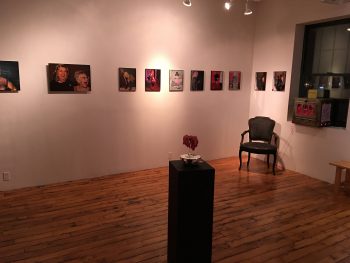
Reality room. BENT, 2016.
The reality room showcases a row of snapshots of men wearing wigs, women’s clothing and make-up.They look like they’re all having a blast: laughing, showing cleavage, revealing the thigh line of black stockings.
In the same room, on the opposite wall, is Marder’s journal, a sociological observation of
degrees of sexual, sexy and social behaviors; a list of the fantasies men prefer to act out after they’ve dressed up as women (job interviews, caught in the act of sexual betrayal, automat slut).
Once you pass through the black curtain, to the dreamland side of her installation, Marder shows you the nuts and bolts of the business of cross dressing all bathed in soft pink lights. There’s a lounge area to relax, listen to music, a basket of soft buttered buns. In one corner is a softly lighted bridal gown ( “Hindu men’s favorite fantasy,” she pointed out.) In front of the leather sofa and floor cushions is a glass topped coffee table filled with an assemblage of breast protheses.
To the far right in the dreamland area, is a small closet of a room lined floor-to ceiling with mirrors. It has a shag rug and a chandelier composed of pink fluffy petticoats. In this room gallery goers can try on one of a handful of wigs and/or high heels, test dozens of tubes of lipstick, touch feathers. Girl heaven.
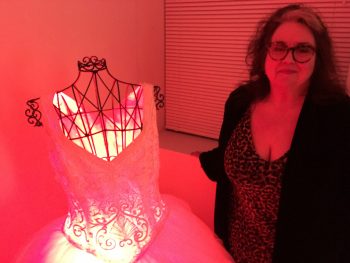
Samantha Marder with Bridal Gown. BENT, 2016
Marder, who in addition to being an artist-exhibitor at Atlantic Works Gallery, has worked as a cross dresser facilitator for the past 20 years. She has a degree in cultural anthropology and previously worked as a social worker.
Her show BENT is an intellectually eroticized exhibit that agrees reality is a construct; that plays with philosophical ideas about reality and gender; that acknowledges real men can’t dress up as women and hang out at their country club or attend their business’s board meetings.
“Usually men who want the experience of dressing up as a woman have to go to a dominatrix or prostitute. I am neither.” She finds clients through ads in magazines, such as Boston Magazine.
Marder has a collection of over 200 miniskirts in her studio and perhaps twice as many panties. “Certain men reduce anxiety and stress by cross dressing, ” Marder said. “I am their fairy godmother, their facilitator, their guide.”
BENT is Marder’s second gender exploring installation at Atlantic Works Gallery.
BTW: in the 30s Meret Oppenheim sold her fur lined cup to the MoMA in New York for $50. Since this was the first work by a woman the museum acquired, Oppenheim is playfully called the First Lady of MoMA.
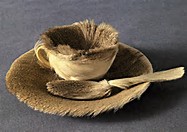
Object (or Luncheon in Fur), by Meret Oppenheim. In 1936, Oppenheim wrapped a teacup, saucer and spoon in fur. In the age of Freud, a gastro-sexual interpretation was inescapable. Even today, the work triggers intense reactions.
